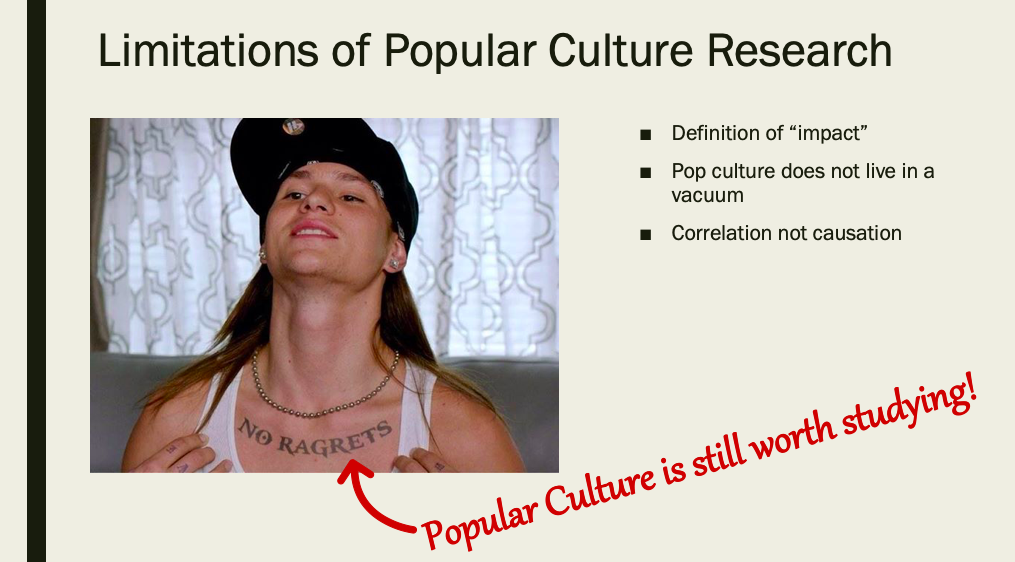Popular Culture - A Force for Good or Evil? (AKA CMN 2180B - Fall 2019 - Class 6)
Studying Popular Culture - and the field of Popular Culture studies more broadly - isn’t just about watching Big Brother, writing about Sean Paul, or keeping up with the Kardashians. One of the things that I hope comes across through my classes and these blog posts is that popular culture can truly have an influence on our lives. It has the potential to affect our behaviour and perceptions, to shape our identity and our relations with and expectations of other people. That’s really what the rest of my course is about - thinking about and examining different ways of measuring and studying the impact of popular culture.
With that in mind, in Class 6, we looked at a report that asked whether popular culture could be used as a tool for positive social change.
As we’ve seen already, popular culture can be an important source - sometimes our only source - of information about people, places and things. Take what’s happening in the Amazon right now. If you’ve never been there before, your only source of information is likely what you’ve seen in the media - either fiction or non-fiction. Popular culture allows us to have enjoyable, emotional experiences with characters, places, and situations that we might not otherwise get to see or interact with.
Popular culture also helps us define our social reality by identifying our group and individual identities. It illustrates behaviour norms and social boundaries and demonstrates and depicts group rituals.
Popular culture also facilitates the construction of identity groups - it helps us to identify “in-groups” (groups that are like us) and “out-groups” (groups that aren’t like us). In so doing, popular culture teaches us about intergroup dynamics - or, how one group should treat another group. This scene from the film Mean Girls illustrates this point well.
Popular culture has been linked to the creation of negative public opinion towards specific groups, such as immigrants and people of colour. It perpetuates these stereotypes by making them readily available - popular culture is everywhere - and, in turn, shapes our perceptions and behaviours towards these ‘other’ groups.
But, if popular culture has the power to create negative stereotypes, then more authentic (non-stereotyping) representations should be able to create positive perceptions of outgroups.
Or at least that’s theory! Think about the portrayal of David Palmer on Seasons 1 to 5 of the television series 24 from 2001-2006. Palmer, played by actor Dennis Haybert, was a strong, confident, intelligent, and competent African-American President. He was seen week after week handling high-stress situations, managing terrorist and political threats, while maintaining his integrity and putting the interests of the American people before his own. There’s room to suggest that this portrayal paved the way for another strong, confident, intelligent and competent African-American President just a few years later IRL.
How can popular culture do this? Why can it have an impact - either ‘positive’ or ‘negative’?
1. It presents ‘information’ in an entertaining, compelling way.
We’ll be examining some scholarly readings on the television series 24 later in the semester, but, suffice to say that the series is action-packed, full of drama, and each episode ends on a cliff-hanger. The use of the ticking clock to keep audiences glued to their chair, the ups-and-downs experienced by the main and secondary characters go a long way to engage and entertain. The same applies to many other forms of popular culture - irrespective of format (movies, books, music, videogames) or genre (science-fiction, comedy, action, horror, punk, pop, etc).
2. It generates empathy and emotion
Popular culture allows us to connect with people (and stories) on an emotional level. If you’ve ever cried, laughed, or screamed while watching or reading something, then you’ve experienced it.
3. It is an opportunity for indirect contact
It also provides vicarious experiences - carrying out specific behaviours, dealing with problems or social issues, interacting with groups that we might not normally get to interact with. When these experiences are ‘positive’, occur with likeable people in realistic settings, they improve our perceptions and attitudes towards that issue or outgroup.
4. It has a “realistic” or believable story
In order to be effective, popular culture has to pull us into the story. To do this, it must have an engaging narrative that transports us into the story, rather than pushing content at us (something that advertising and product placement is often criticized for doing).
Despite these findings, studying popular culture and the impact of popular culture has it limitations. First, across the field of study that are varying definitions of ‘impact’ and ‘effect’. This means that it can be difficult to generalize findings. Second, popular culture does not live in a vacuum. This means that popular culture is but one factor that influences our behaviour, our perceptions and, ultimately, social change. Finally, for similar reasons, studies pertaining to the impact of popular culture cannot determine causation - only correlation. They can suggest a relationship between two phenomenon - for example, the portrayal of David Palmer on 24 and the election of Barack Obama - but cannot prove that one caused the other.
These limitations aside, popular culture is still worth studying because, as we’ll see over the course of the rest of the semester (and over the course of the rest of these blog posts) it can still have an impact.




